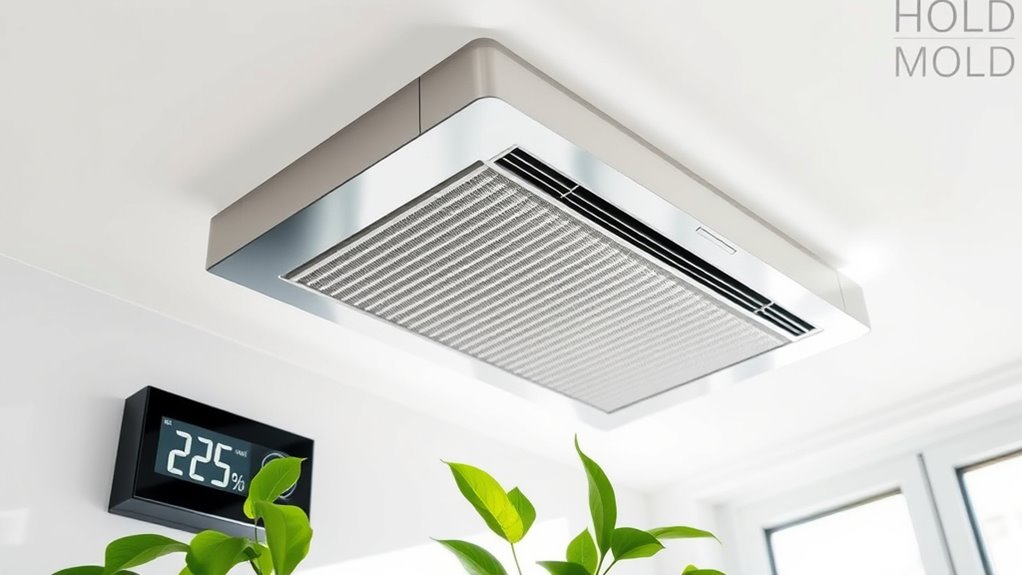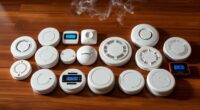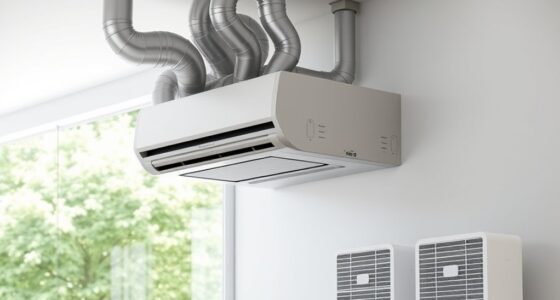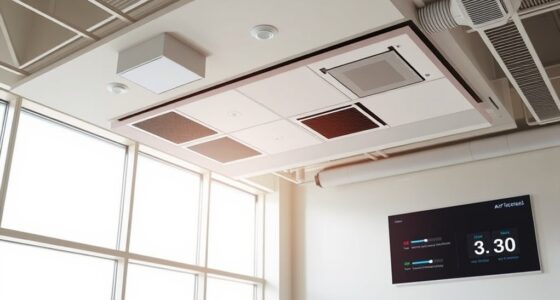To manage humidity through your HVAC for mold prevention, guarantee your system maintains indoor humidity levels between 30-50%. Regularly service your HVAC, clean filters, and consider adding a dehumidifier or humidifier linked to your system for precise control. Proper maintenance prevents excess moisture, reduces mold growth, and protects your home’s structure. Staying attentive to humidity levels and using smart monitoring tools can help you stay ahead of problems; more useful tips await if you continue exploring.
Key Takeaways
- Regularly maintain and clean HVAC filters and ducts to ensure proper airflow and humidity control.
- Use smart humidity sensors and thermostats for automatic adjustments to maintain ideal moisture levels.
- Keep indoor humidity between 30-50% to prevent mold growth and reduce condensation risks.
- Incorporate dehumidifiers or humidifiers connected to HVAC systems for precise moisture management.
- Monitor indoor humidity levels consistently to detect and address potential mold-prone conditions early.
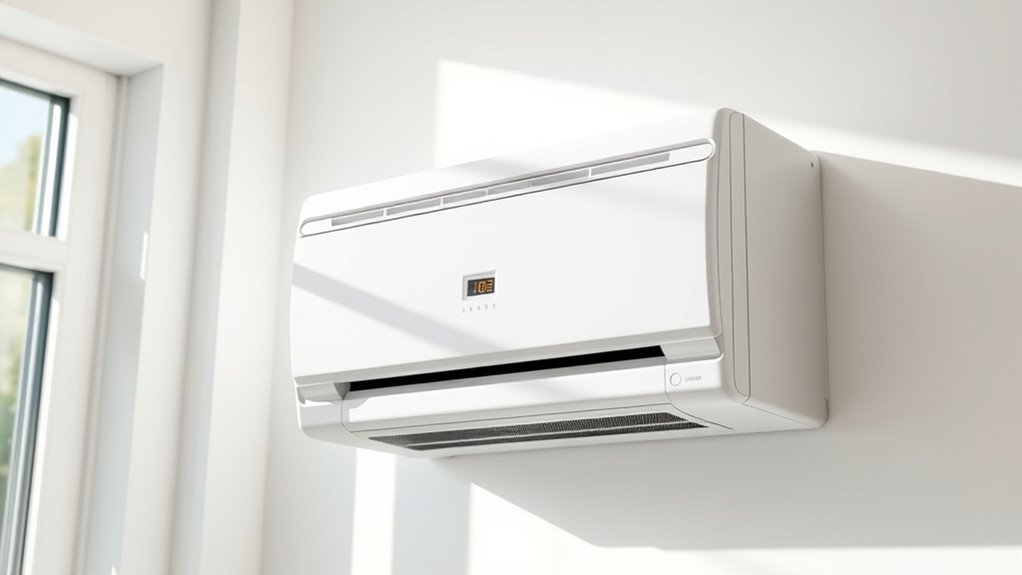
Maintaining proper humidity levels is essential for preventing mold growth in your home, and your HVAC system plays a critical role in this process. When humidity is too high, it creates an environment where mold spores thrive, compromising your indoor air quality and potentially leading to health issues. Conversely, excessively dry air can cause discomfort and other problems. Your HVAC system helps regulate humidity, guaranteeing it stays within the ideal range of 30-50%. By doing so, you maintain healthy air quality and improve your home’s overall comfort. Proper humidity control also enhances energy efficiency because your system doesn’t have to work as hard to maintain temperature stability when humidity levels are balanced. When humidity is well-managed, your HVAC can operate more efficiently, reducing energy consumption and lowering utility bills.
To effectively manage humidity, you should regularly inspect and maintain your HVAC system. Clean filters and ducts ensure proper airflow, which is essential for consistent humidity control. An overworked or poorly maintained system can struggle to keep humidity levels steady, leading to excess moisture or overly dry air. Installing a dehumidifier or humidifier connected to your HVAC system can provide precise control, especially during seasonal fluctuations. These devices help maintain air quality by removing excess moisture or adding humidity as needed, preventing mold spores from settling and multiplying. When you keep humidity in check, you also prevent condensation issues that can damage walls, ceilings, and furniture, further supporting a healthy living environment. Additionally, understanding pool terminology, such as relative humidity and dew point, can help you better comprehend how moisture behaves indoors and outdoors.
Smart thermostats and humidity sensors make it easier to monitor and adjust humidity levels automatically. By setting the right parameters, your HVAC system can respond in real-time, maintaining ideal air quality and energy efficiency. These smart devices help you avoid the pitfalls of manual adjustments, which can be inconsistent and less effective. They also give you insight into your indoor environment, so you can identify and address issues before mold becomes a problem. When you focus on controlling humidity, you reduce the risk of mold growth, protect your belongings, and promote a healthier indoor atmosphere. Plus, when your HVAC system runs efficiently, it prolongs its lifespan and minimizes repair costs over time.
Ultimately, managing humidity through your HVAC system isn’t just about comfort; it’s a proactive way to safeguard your home’s air quality and boost energy efficiency. By paying attention to humidity levels and maintaining your system properly, you create a healthier, safer living space. This approach helps prevent mold growth and its associated health risks while reducing energy consumption, making your home more sustainable and comfortable year-round.
Frequently Asked Questions
How Does HVAC Impact Indoor Air Quality Besides Humidity?
Your HVAC system impacts indoor air quality beyond humidity by improving air filtration and circulation. It filters out dust, pollen, and pollutants, reducing allergens and respiratory irritants. Proper air circulation ensures fresh air replaces stale indoor air, preventing buildup of contaminants. Regular maintenance keeps your system efficient, helping you breathe cleaner air and creating a healthier environment. This way, your HVAC actively contributes to better overall indoor air quality.
What Are the Signs of Improper HVAC Humidity Control?
You might notice signs of improper HVAC humidity control, like musty odors or condensation on windows, indicating humidity imbalance. Persistent mold spots or peeling paint also signal moisture issues caused by equipment malfunctions or poorly maintained systems. When your HVAC isn’t regulating humidity correctly, it creates an environment conducive to mold growth and structural damage, so stay alert to these warning signs to address problems early and maintain a healthy indoor environment.
Can Mold Grow Even With Low Humidity Levels?
Yes, mold can still grow even with low humidity levels because mold resilience varies, and some mold species thrive in slightly higher humidity. While maintaining humidity below typical thresholds (30-50%) helps prevent mold growth, occasional fluctuations or hidden moisture can create conditions conducive to mold development. Consistently monitoring humidity thresholds and addressing any leaks or moisture issues are essential for effective mold prevention, even when humidity seems low.
How Often Should HVAC Systems Be Inspected for Mold Prevention?
You should inspect your HVAC system at least twice a year for mold prevention. Routine maintenance helps identify potential issues early, and checking air filtration ensures mold spores don’t circulate. Regular inspections keep the system clean, improve air quality, and prevent mold growth. Don’t forget to replace filters regularly, especially during high humidity months. Staying proactive with maintenance is key to maintaining a mold-free environment.
Are There Specific HVAC Features That Better Prevent Mold Growth?
Think of your HVAC system as a vigilant guardian. Features like dehumidifier integration help keep humidity levels low, much like a gust of fresh air in a stuffy room. HEPA filtration traps mold spores before they spread, acting like a protective shield. These features work together, preventing mold growth and ensuring your home stays safe and healthy. Investing in them is like giving your home a strong, mold-resistant armor.
Conclusion
By maintaining your home’s humidity levels between 30-50%, you markedly reduce mold growth risks. Some believe that keeping humidity low alone prevents mold, but it’s not the whole story—you also need proper ventilation and regular cleaning. Think of HVAC as your home’s shield; it actively controls moisture and airflow. When used correctly, it’s proven that managing humidity is one of the most effective ways to prevent mold, so trust your system to keep your space safe and healthy.
